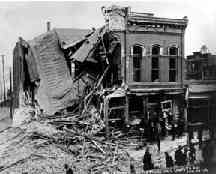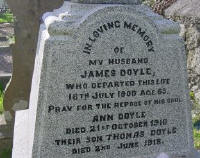|
|
News from Home
|
|
|
"We laid him down in yon
green garden,
With Union men on every side,
And swore we'd make one mighty Union,
And fill that gallant man with pride."
Unknown

|
| Butte
mining was synonymous with ‘Unions’. Numerous unions made their home in
Butte. As early as 1878, Butte workers unionized forming the Butte Miners
Union #1. This Union evolved into the Western Federation of Miners (WMF)
with one-third of national membership hailing from Butte. An annual Miner’s
Union Day picnic became an opportunity for union members and their families
to celebrate and was complete with drilling competitions and other similar
contests. A ‘sour note’ to union prosperity played out about 1912. The
Company issued ‘rustling cards’ to prospective new hires. If you didn’t have
a card, you couldn’t be hired. Of course, the Company controlled who
received the cards and, thus, kept out those it deemed undesirable.
Throughout and beyond Henry’s time in Butte, the Company and the unions had
an uneasy relationship and each would persist in testing the strength of the
other. |
| Henry J. may
have had some forewarning of the situation in Butte. It’s
possible that news reached Ireland of the events of June 13, 1914. The day of the annual celebration of
Miner’s Union Day a bitter battle broke out between opposing Unions. A
crowd ransacked the Butte Miner’s Union Hall after their own parade
had erupted into a riot. Accusing WFM leaders of election fraud and
collusion with the copper companies, the insurgents blew up the Union
Hall, leading Montana’s governor to send in the state
militia to restore order. While the city was under martial law, company
officials withdraw union recognition, leaving miners on both sides of
the dispute without job protection. So by the time Henry J. reached the
mines of Butte, the era of the closed shop had ended. |

Butte Miner's Union Hall |
| 1916 brought
news from home. In July, James Larkin arrived in town to speak to the
miners about the “Rising”, when on April 24; Pádraig
Pearse had stood on the steps of the General Post Office in Dublin and declared Ireland
a Republic. Thousands came out to
listen to Larkin and undoubtedly Henry J. and his co-workers would have
been among the crowd. Larkin, who was reared by his grandparents in
Newry, Co. Down may have perhaps recognized the Mourne dialect as he
mingled among the crowd. Then in late October Henry will have received
the sad news that his mother had died on October 21, and was buried in
the family plot in Massforth graveyard, Kilkeel.
 |
The final resting place of
Henry's mother and father - Anne and James Doyle.
At the time of his mother's burial, Henry was working in the Copper
Mines of Montana. |
|
|
              |
| |
 |
|
|
